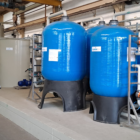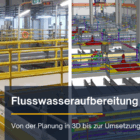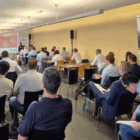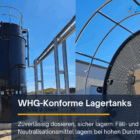Precipitation, also known as precipitation, is a chemical process in which dissolved substances in a liquid are converted into a solid phase by chemical reaction. These solids, known as precipitates, can then be removed from the water or wastewater by sedimentation, filtration or flotation. Precipitation is one of the central methods in industrial water and wastewater treatment, as it effectively contributes to the removal of dissolved pollutants such as heavy metals, phosphates and organics.
Table of contents
The basics of precipitation
Definition of
Precipitation refers to the formation of a sparingly soluble solid from a solution by adding a precipitating agent. precipitantwhich enters into a reaction with the dissolved substances. This typically occurs through a change in chemical conditions such as pH value, concentration or temperature.
Reaction principle
The chemical reactions are based on the solubility product of a certain substance being exceeded, causing it to precipitate out of the solution.
Types of precipitation
A distinction is made between different forms of precipitation depending on the target and area of application:
1. chemical precipitation
- Objective: Removal of dissolved inorganic or organic pollutants.
- Examples:
- Felling of Phosphates:
- Precipitants: aluminum or iron (III) salts.
- Felling of Heavy metals:
- Precipitant: milk of lime, sodium hydroxide or organosulphide.
- Felling of Phosphates:
2. coagulation and flocculation
- Objective: Removal of colloidal dissolved substances by destabilization.
- Mechanism:
- Coagulation: Neutralization of surface charges by precipitants.
- Flocculation: Formation of larger particles (flocs) by polymer or flocculation aids.
3. oxidative precipitation
- Objective: Conversion of dissolved substances into poorly soluble forms by oxidation.
- Example:
- Oxidation of iron(II) to iron(III) and subsequent precipitation.
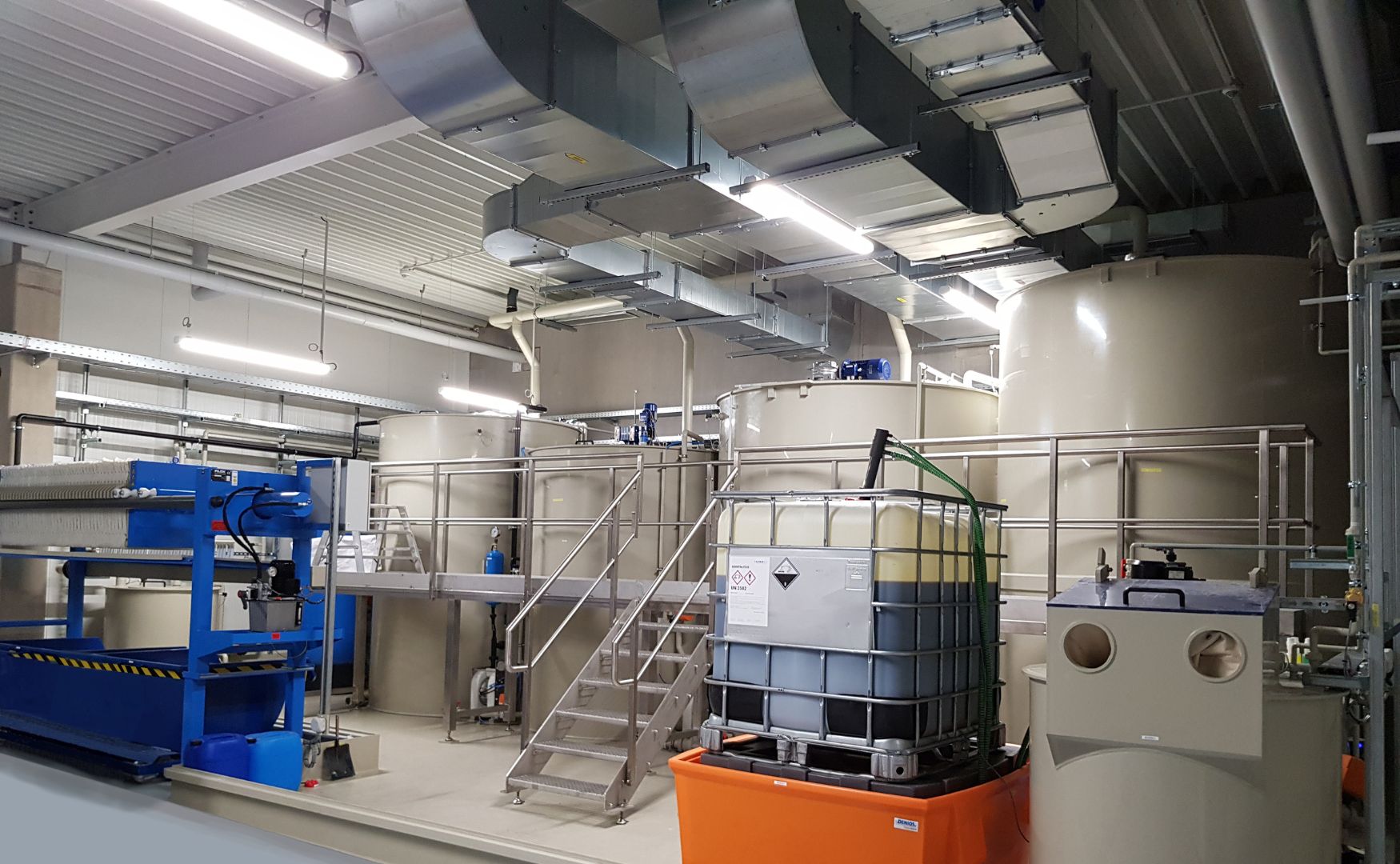
Photo: Our CP system ALMA CHEM MCW for the precipitation and flocculation of heavy metals, AOX, hydrocarbons and cyanides
Chemicals and materials for precipitation
The selection and targeted use of precipitants and additives are crucial for the efficiency and effectiveness of precipitation in water and wastewater treatment. These chemicals influence the type and speed of the reactions as well as the stability and separability of the precipitates formed. An optimal combination of these substances enables the removal of pollutants, the adjustment of water quality and compliance with legal requirements.
Precipitant
Precipitants are chemical substances that are deliberately introduced into the water or wastewater flow in order to convert dissolved substances into an insoluble form. The choice of precipitantdepends on the type of substances to be removed, the chemical properties of the medium and the target values to be achieved.
Metal hydroxide precipitation
- Application: Metal hydroxide precipitation is often used to remove heavy metals such as copper, zinc or nickel. These substances form poorly soluble hydroxides in alkaline environments, which are easy to separate.
- Typical precipitants:
- Sodium hydroxide (NaOH): Is often used because it is easy to dose and enables a quick reaction.
- Calcium hydroxide (Ca(OH)₂): Also known as milk of lime, it is inexpensive and can also be used as a pH regulator.
- Magnesium hydroxide (Mg(OH)₂): Provides mild pH regulation and is suitable for more sensitive systems.
Phosphate precipitation
- Application: The aim of phosphate precipitation is to reduce phosphorus levels that can lead to eutrophication of water bodies. Precipitation takes place through the formation of poorly soluble phosphates.
- Typical precipitants:
- Aluminum compounds (Al₂(SO₄)₃): Aluminum forms insoluble AlPO₄ compounds with phosphates, which are easily sedimented.
- Iron(III) chloride (FeCl₃): Particularly efficient in the precipitation of phosphates and at the same time effective against organic loads.
- Iron(II) sulphate (FeSO₄): Suitable for precipitation under reducing conditions, e.g. in anaerobic systems.
Sulphide precipitation
- Application: Sulphide precipitation is often used to remove heavy metals, as these form extremely poorly soluble sulphides with sulphur compounds. It is mainly used in the electroplating industry and for industrial wastewater.
- Typical precipitants:
- Organosulfide: Used in controlled environments for direct sulfide precipitation.
- Sodium sulphide (Na₂S): A safe and easy-to-use precipitant for sulphide precipitation.
Lime precipitation
- Application: Lime precipitation is mainly used to remove hardness formers such as calcium and magnesium or to neutralize acidic wastewater.
- Typical precipitants:
- Calcium carbonate (CaCO₃): Used to reduce acidity and precipitate heavy metals.
- Calcium hydroxide (Ca(OH)₂): Increases the pH value and at the same time supports the precipitation of metals or phosphates.
Additives
In addition to the precipitants, the following are often used flocculants and neutralizing agents are often used to increase the efficiency of precipitation and facilitate the separation of the solids formed.
Flocculant
- Function: Flocculants promote the formation of larger and more stable flocs from the finely dispersed precipitates. They bind smaller particles into larger agglomerates that are easier to settle or filter.
- Typical substances:
- Organic polymers: e.g. polyacrylamides, which act by charge neutralization or bridging.
- Inorganic additives: e.g. bentonite, which supports flake formation due to its large surface area.
- Application: In sedimentation and flotation plants to optimize separation performance.
Neutralizing agent
- Function: Many precipitation reactions are strongly pH-dependent. A precise pH value is crucial to minimize the solubility of the target substances and to form stable precipitates.
- Typical substances:
- Acids:
- Hydrochloric acid (HCl) or sulphuric acid (H₂SO₄) are used to lower the pH value, e.g. for sulphide precipitation.
- Bases:
- Sodium hydroxide (NaOH) or milk of lime (Ca(OH)₂) raise the pH value, e.g. during hydroxide precipitation.
- Acids:
- Application: The pH value is precisely controlled by automated dosing systems based on real-time measurements.
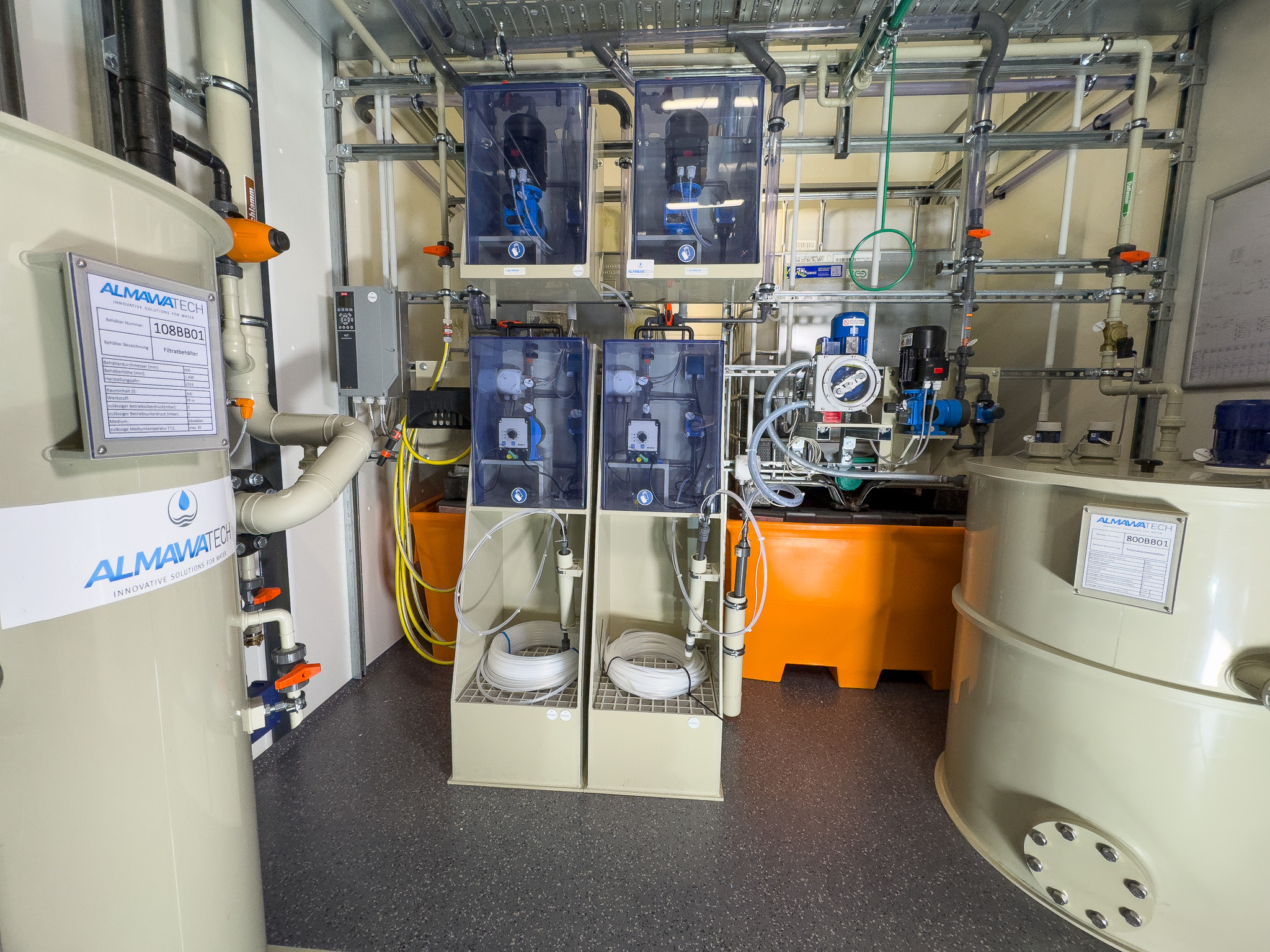
Photo: IBC dosing station for precipitants and neutralizing agents, dosing and preparation station for flocculants and dosing station for sodium bisulphite and hydrogen peroxide, installed in the ALMA MODUL technical room container
Construction of CP system for precipitation
A precise design of the CP system is crucial for the efficiency of the precipitation process. It includes the following components:
1st dosing station
The dosing station is the first step in the reaction line and plays a central role in the precise and needs-based addition of precipitants and flocculants.
Purpose:
- Ensuring that the required chemicals are introduced into the system in the correct quantity and at the optimum point.
- Adaptation of the dosing to the actual process conditions, such as fluctuations in the feed load or the pH value.
Technology:
- Dosing pumps:
- High-precision pumps (e.g. diaphragm or peristaltic pumps) ensure exact chemical dosing.
- Integration of control loops that react to measurement signals (e.g. pH, conductivity).
- Storage container:
- Storage of precipitants, e.g. aluminum or iron solutions, in chemical-resistant containers (PE, stainless steel).
- Automatic refilling systems and agitators prevent deposits and ensure a homogeneous solution.
- Mixing systems:
- Static mixers or injectors ensure that the precipitants are evenly distributed in the feed water.
- Dosing pumps:
2. reaction vessel
The chemical reactions that lead to the formation of precipitates take place in the reaction tank. Sufficient residence time, uniform mixing and optimum chemical conditions are crucial here.
Purpose:
- Ensuring complete reaction between the dissolved pollutants and the precipitants.
- Providing the necessary reaction time and physical conditions for the formation of stable and easily separable precipitates.
Design:
- Agitators:
- Mechanical or hydraulic agitators ensure uniform mixing to maximize contact surfaces between the reagents and target substances.
- The rotational speed can be adapted to the properties of the precipitates in order to avoid abrasion or destruction of the particles.
- Multi-stage reactors:
- Separate chambers for precipitation and flocculation optimize the process conditions:
- Precipitation zone: Rapid mixing to enable an immediate reaction.
- Flocculation zone: Slow flow conditions promote the aggregation of precipitates into larger particles (flocs).
- Separate chambers for precipitation and flocculation optimize the process conditions:
- pH control:
- Control loops for automated pH adjustment are essential, as many precipitation reactions are strongly pH-dependent (e.g. hydroxide precipitation at pH 8-9).
- Agitators:
3. sedimentation or filtration system
The removal of the precipitates formed is the final step after the chemical reaction has taken place. Different separation techniques are used depending on the properties of the precipitates and process requirements.
Purpose:
- Separation of the solids (precipitates) from the liquid phase to obtain clarified water.
- Preparation of solids for disposal or further processing.
Techniques:
- Settling basin:
- Sedimentation tanks with clearing devices (e.g. sludge scrapers) collect the precipitates at the bottom and discharge them for sludge treatment.
- Turbidity-free overflow areas ensure the discharge of the clarified water.
- Pressure filtration:
- Use of chamber filter presses or disk filters to separate solids from highly loaded liquid streams.
- High retention rate even with the finest precipitates.
- Flotation:
- Use of dissolved air flotation (DAF) to remove precipitates that have a low density or float on the surface.
- Settling basin:
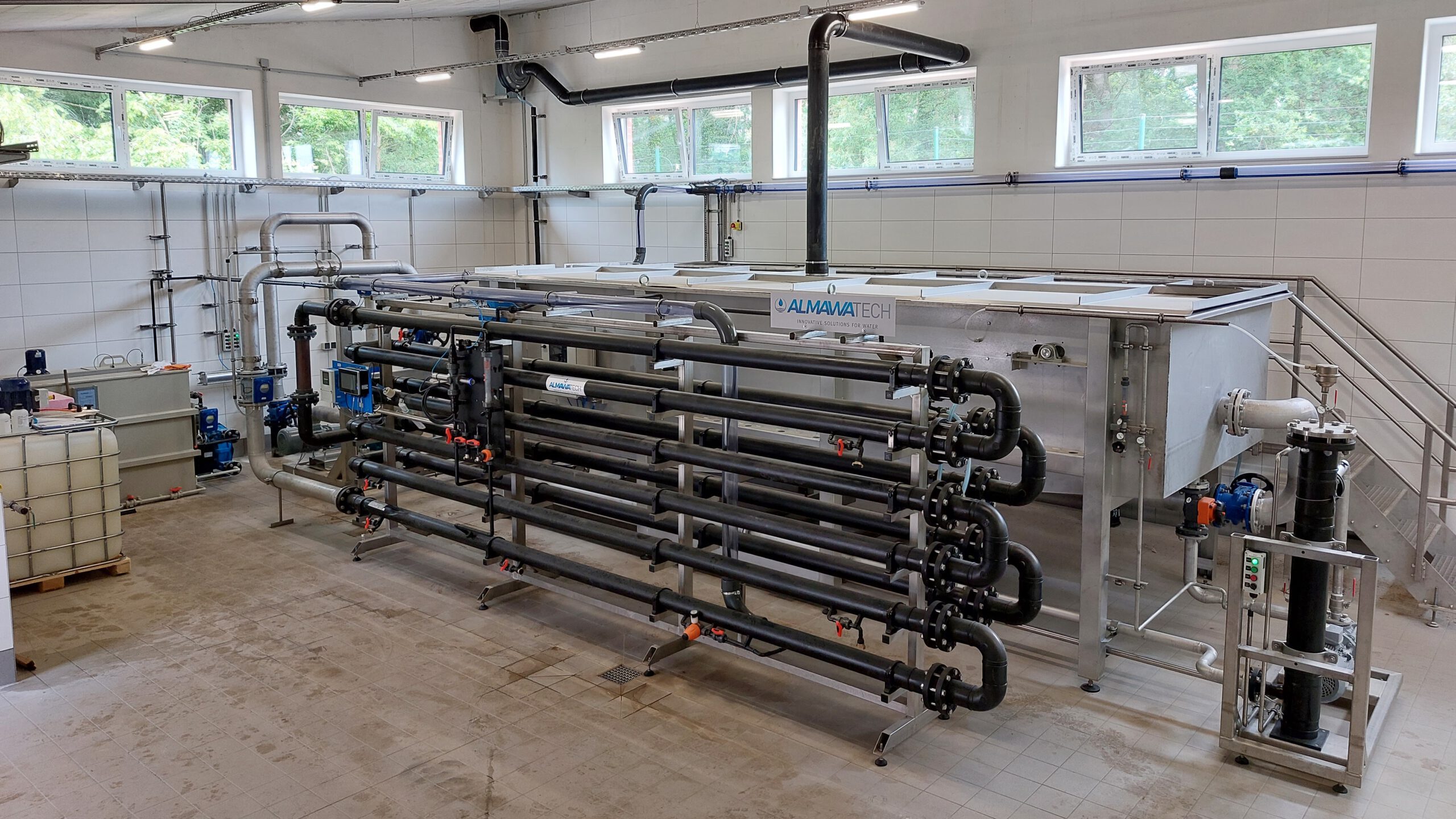
Photo: ALMA NeoDAF flotation system with reaction loop for mixing in precipitant, neutralizing agent and flocculant
Factors influencing precipitation
1. pH value
- Many precipitation reactions are strongly pH-dependent.
- Example:
- Optimum pH range for hydroxide precipitation: 8-9.
- Exceeding the limit can lead to redissolution.
2. concentration of the reactants
- The dosage of the precipitant must be precisely matched to the concentration of the target substances.
- Insufficient dosage: Incomplete precipitation.
- Overdosing: formation of by-products and higher operating costs.
3. temperature
- Higher temperatures often promote the reaction rate, but can also increase solubility.
4. dwell time
- Sufficient contact time in the reaction section is necessary to ensure the formation of stable precipitates.
Conclusion
Precipitation is a versatile and effective method for removing dissolved pollutants from water and wastewater. It requires careful planning and monitoring, as factors such as pH value, concentration and retention time have a significant influence on success. The use of modern control technology and optimized reaction sections can increase efficiency, reduce operating costs and ensure compliance with legal requirements. Precipitation therefore remains an indispensable part of modern water treatment.
For further information on our products, please feel free to contact us at any time!


